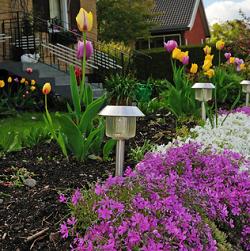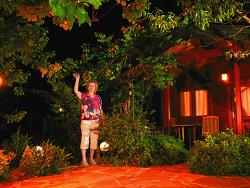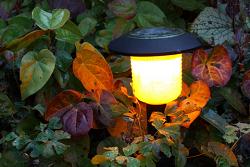Solar-Powered Garden Lights: Energy-Efficient and Flexible Lighting Fixtures for Your Foliage
Solar powered garden lights provide a high level of flexibility at no energy cost.
Solar powered garden lights have transformed the yard. Before their existence, the installation of garden lights was remarkably expensive, as weatherproof, low voltage cables needed to be attached to every light source. Now, with the introduction of solar powered garden lights, people have the option of lighting their yard and garden in new ways that only the wealthy could afford before, and at perfect energy-efficiency to boot. In this article, I will discuss the benefits of solar powered lights and how they can be used in your garden to provide the most beautiful design.
Advantages of Solar Powered Garden Lights

Placing lights inside of your garden enables you to see your garden even in darkness.
The largest advantage of solar powered garden lights is their sheer flexibility. Unlike lights that are attached to cables, they can be picked up and placed almost anywhere in your yard that has direct sunlight. Even those places where direct sunlight is not available can be lit by using a short cable and placing the solar panels somewhere that itself gets direct sunlight. This means that you can place lights by any bush in your garden, on your garden walls and trellises or in your garden’s open areas. Later, if you decide you don’t like the appearance of something, you can simply move it.
The second major advantage is power efficiency. When it comes to your electricity bill, solar powered garden lights are what is called “perfectly efficient”, meaning that they cost nothing. As a result, you will see not only installation savings but power savings as well once you’ve installed solar powered lights of any kind.
Using Solar Powered Garden Lights
The primary purpose of garden lighting is to illuminate your foliage and the area around your foliage. Without proper lighting, all of your hard work in the garden simply disappears at night, and your guests cannot see it. Introducing garden lighting allows you to use your foliage as a part of the attractiveness of your yard even after the sun goes down. However, garden lighting is more complex than simply placing a few lights. It is important to be concerned with framing, color and ambient light.
Framing

Having lights on your foliage makes your outdoors feel more like a room than like a big empty space.
One of the largest difficulties with unlit yards is that it feels like you are in a big black hole. The house is usually somewhat lit, so the rest of the back yard is an almost living shadow. This is of course unattractive and even a little creepy. One of the primary purposes that garden lighting can help serve is to provide your backyard with what is called “framing”. By casting light on vertical plant, you give your backyard the feeling of walls, and by casting light on the bottom of tree branches, you give your backyard the feeling of having a ceiling. This creates what is sometimes called an “outdoor room” and removes the agoraphobic nature of the yard at night.
Color
Warm (reddish) light looks very good on human faces, because it brings out our natural colors and makes us look healthy and alive. Conversely, cool (bluish) light tends to make us look ill. For plants, this usual rule is completely reversed. Warm light makes plants look sickly and dying, as it hides the chlorophyll in their leaves. Conversely, cool light brings out the green in the leaves, and therefore makes the leaves look healthier.
As a result, when you are choosing solar powered garden lights, you should choose cooler light bulbs, rather than the more traditional warm bulbs. LED light fixtures come in cooler colors, as do fluorescents. However, incandescent light bulbs and halogen light bulbs are always on the warm spectrum and therefore make poor garden lights.
Ambient Light
The light that bounces off of your walls, plants and ground shone by your garden light will also deflect into your yard and patio. Deflected light like this is called “ambient light”. The ambient light from the garden has some distinct properties that need to be accounted for when making decisions about the rest of your yard.
The biggest problem with the ambient light from your garden is that it will be cool light that is further tinged green by the plants themselves. Therefore, you will need to have other, warm sources of light in your backyard. Otherwise, you and your guests will look green like they just ate some bad chicken. These lights should be especially warm, to counter the greening effect of your garden lights.
Disadvantages of Solar Powered Garden Lighting

Warm colored light looks terrible on plants, washing out their chlorophyll and making them look dead.
Solar powered garden lighting does have some disadvantages when compared to other forms of garden lighting. The first is that solar powered lighting can be difficult to control. Some solar powered lighting can be programmed to turn on and off at different times with light control systems. However, if you ever decide to change the programming, you will need to do it fixture by fixture. A remote control light switch can be purchased, though these systems can be expensive or complicated. Overall, the difficulty is that it is more complicated to flip a switch and turn your garden lights on and off like you could with wired garden lighting.
The second difficulty with solar powered garden lighting is that it doesn’t work very well in cold weather. Battery charge dissipates at a faster rate in cold weather, and eventually stops holding charge at all somewhere between -40 and 0 degrees Fahrenheit (-40 and -20 degrees Celsius). Less expensive lights may lose their charge after only a few hours during cold winters, so they may not be appropriate for temperate climates.
Finally, the environmental impact of solar powered lighting is more complex, and I discuss it on my page about solar-powered lighting. The reduced power provides environmental benefit, but the materials in the solar panels, specifically cadmium telluride have their own environmental disadvantages.
Putting It All Together
Solar powered garden lighting has made quality outdoor lighting available at a fraction of its previous cost.
- It is both flexible and energy efficient.
- It can frame your yard, providing you with the feeling of an “outdoor room”.
- Lighting of foliage should be from cool light, but this will need to be counter-balanced when it finally hits human faces.
- Solar lighting functions erratically in freezing weather and its environmental impact is mixed.
Adding solar lights to your garden can help turn your back yard into another room.
Back from Solar-Powered Garden Lights to Solar-Powered Lighting